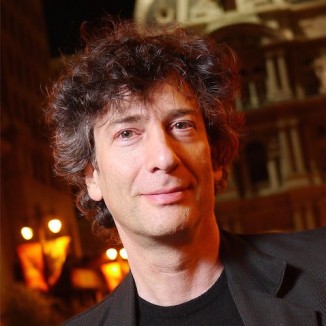100 years ago today, one of the most famous dogs in the world, Hachikō the Akita, was born in Ōdate. He is beloved, revered, and looked at in amazement for his remarkable loyalty to his owner, Hidesaburō Ueno, for whom he continued to wait at the Shibuya Station where they would go home together nine full years after Ueno’s death. READ how it happened and about his legacy… (1923)
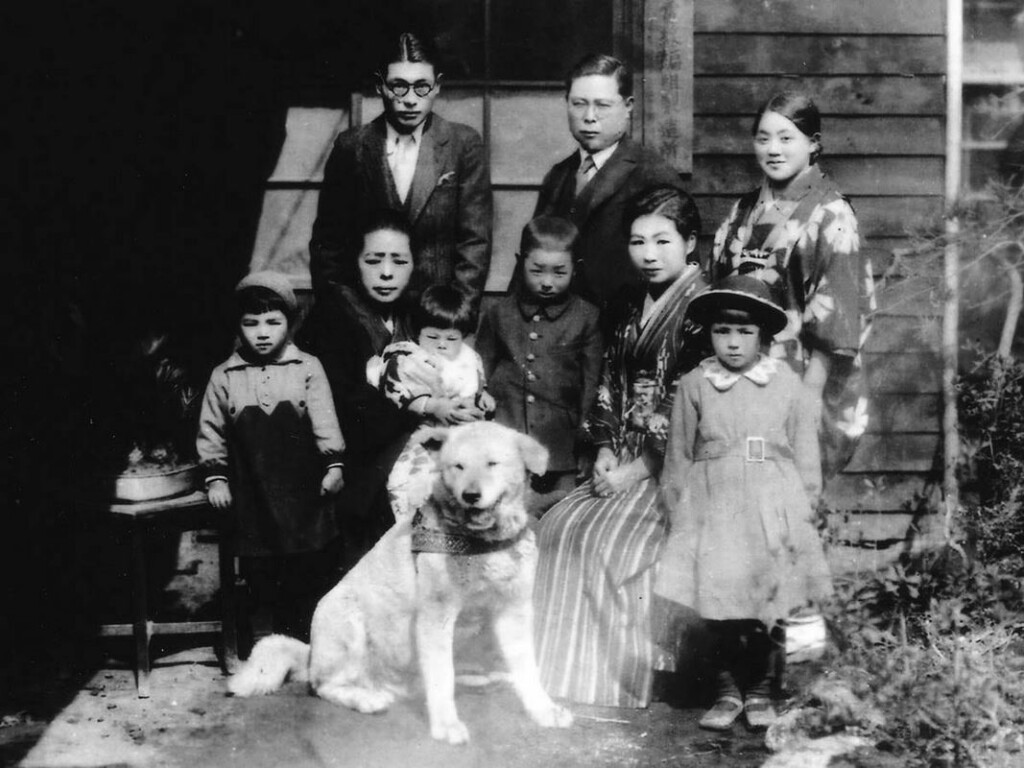 Hachiko with the Ueno family. – pud domain.
Hachiko with the Ueno family. – pud domain.Ueno, a professor in the agriculture department at the Tokyo Imperial University, took Hachikō as a pet and brought him to live in Shibuya, Tokyo. Ueno would commute daily to work, and Hachikō would leave the house to greet him at the end of each day at the nearby Shibuya Station.
On May 21st, the professor suffered a cerebral hemorrhage while he was giving a lecture to his class, and died without ever returning to the train station at which Hachikō waited.
One of Ueno’s students, Hirokichi Saito, who developed expertise on the Akita breed, saw the dog at the station and followed him to the home of Ueno’s former gardener, Kozaburo Kobayashi, where he learned the history of Hachikō’s life. Shortly after the meeting, the former student published a documented census of Akitas in Japan. His research found only 30 purebred Akitas remaining, including Hachikō from Shibuya Station.
He returned frequently to visit Hachikō, and over the years he published several articles about the dog’s remarkable loyalty. In 1932, one of his articles, published in Asahi Shimbun, placed the dog in the national spotlight.
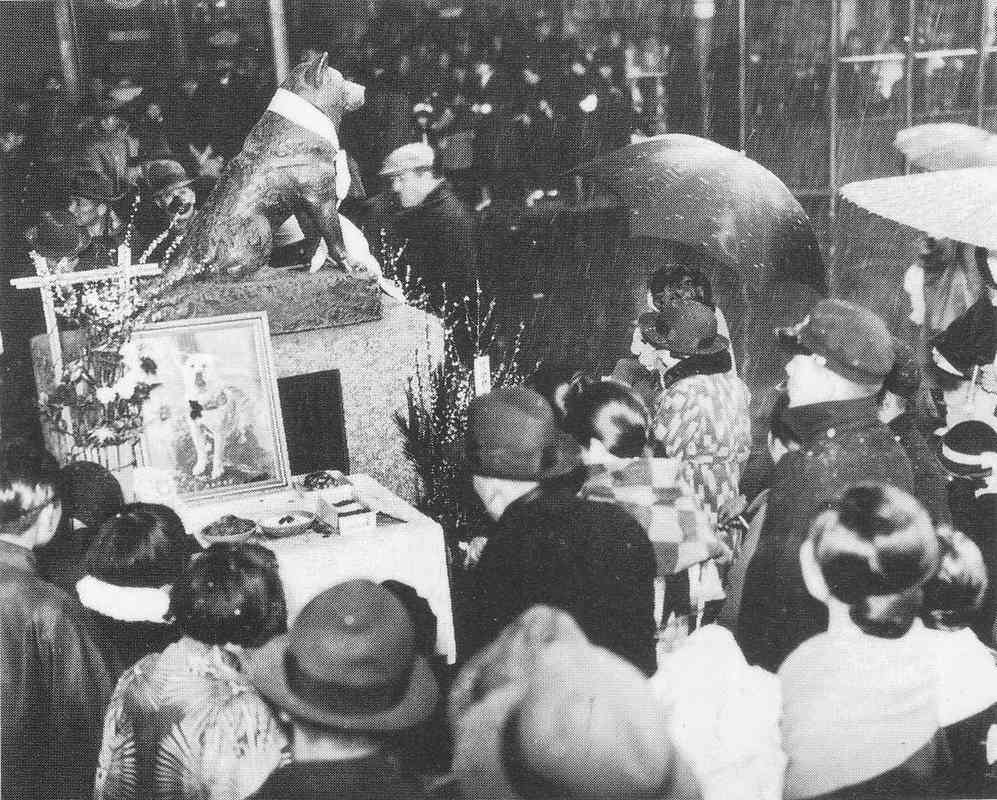 The first anniversary of the death of Hachiko at Shibuya Station – pub domain.
The first anniversary of the death of Hachiko at Shibuya Station – pub domain.Hachikō became a national sensation. His faithfulness to his master’s memory impressed the people of Japan as a spirit of family loyalty to which all should strive to achieve. Teachers and parents used Hachikō’s vigil as an example for children to follow. Teru Ando rendered a sculpture of the dog, and throughout the country, a new awareness of the Akita breed grew. Each year on March 8, Hachikō’s devotion is honored with a solemn ceremony of remembrance at Shibuya Station. Hundreds of dog lovers often turn out to honor his memory and loyalty.
MORE Good News on this Date:
And, 152 years ago today, after going missing for six years, the Scottish medical missionary and explorer of Africa, Dr. David Livingstone, was found by journalist Henry Stanley (pictured), who famously asked upon meeting him, “Dr. Livingstone, I presume?”
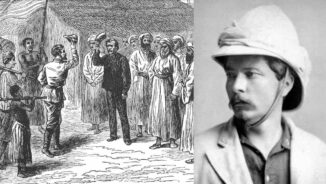
One of the most popular national heroes of late 19th-century Britain, the Congregationalist anti-slavery preacher was one of the first Westerners to make a transcontinental journey across Africa.
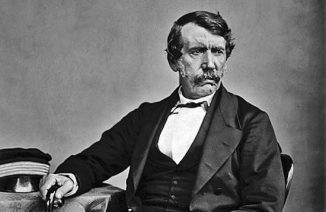 Livingstone preached a Christian message but did not force it on unwilling ears; he understood the ways of tribal chiefs and successfully negotiated passage through their territory by traveling light, and being hospitably received and aided by locals. His fame as an explorer and his obsession with discovering the sources of the River Nile was founded on the belief that if he could solve that age-old mystery, his fame would give him the influence to end the East African Portuguese and Arab-Swahili slave trade.
Livingstone preached a Christian message but did not force it on unwilling ears; he understood the ways of tribal chiefs and successfully negotiated passage through their territory by traveling light, and being hospitably received and aided by locals. His fame as an explorer and his obsession with discovering the sources of the River Nile was founded on the belief that if he could solve that age-old mystery, his fame would give him the influence to end the East African Portuguese and Arab-Swahili slave trade.
The story was dramatized in a 1939 Spencer Tracy film. WATCH a clip… (1871)
33 years ago today, the iconic film Home Alone written and produced by John Hughes, starring Macaulay Culkin, premiered in Chicago, where the comedy takes place. Co-starring Joe Pesci and Catherine O’Hara.
 Photo of the house in Winnetka, Illinois by anarchosyn, CC license
Photo of the house in Winnetka, Illinois by anarchosyn, CC licenseThe film follows Kevin, an 8-year-old boy, who must defend his Winnetka, Illinois home from a pair of scheming burglars (Harry and Marv), after his family accidentally leaves him behind when rushing to the airport with his siblings and relatives to fly to France for their Christmas vacation.
Although Hughes exceeded his $10 million budget, the holiday classic grossed $476.7 million and held the record for the highest-earning comedy film ever, until two decades later. Macaulay Culkin was paid $4.5 million to appear in the 1992 sequel, Lost in New York, compared to $110,000 for the original.
Hughes hatched the movie idea as he was going away on vacation and making a list of everything he didn’t want to forget. “I thought, ‘well, I’d better not forget my kids.’ Then I thought, ‘what if I left my 10-year-old son at home? What would he do?'” He then wrote eight pages of notes that developed into the screenplay. WATCH the trailer and learn where the concept came from… (1990)
Happy 63rd Birthday to Neil Gaiman, the English author and screenwriter whose notable works include The Sandman comic book series and novels Stardust, American Gods, and Coraline, which was turned into a Tim Burton film.
Winner of numerous awards, he is the first author to win both the Newbery and the Carnegie medals for the same children’s work–The Graveyard Book, for ages 10 and up. In 2013, The Ocean at the End of the Lane was voted Book of the Year in the British National Book Awards. (1960)
Also, on this day in 1973, Elton John hit No.1 on the US album chart for the third time with his seventh LP Goodbye Yellow Brick Road. The double disk set became his best selling studio album with worldwide sales of over 15 million copies, certified 8× platinum.
 Recorded at the Château d’Hérouville in France, the album’s hits included the Marilyn Monroe tribute, Candle in the Wind, as well as Bennie and the Jets, Saturday Night’s Alright for Fighting, Goodbye Yellow Brick Road, plus Funeral for a Friend/Love Lies Bleeding, Harmony, and Gray Seal. WATCH a video on the Making of the LP…
Recorded at the Château d’Hérouville in France, the album’s hits included the Marilyn Monroe tribute, Candle in the Wind, as well as Bennie and the Jets, Saturday Night’s Alright for Fighting, Goodbye Yellow Brick Road, plus Funeral for a Friend/Love Lies Bleeding, Harmony, and Gray Seal. WATCH a video on the Making of the LP…
And, 54 years ago today, Sesame Street first aired on 180 PBS public television stations using Jim Henson’s puppets to teach letters, numbers, and colors, with the goal or preparing less advantaged children for school. Created by Joan Ganz Cooney and Lloyd Morrisett and produced by their Children’s Television Workshop, the show by 2009 was translated and broadcasting in more than 140 countries.
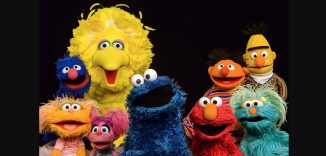
Sesame Street is celebrating its 50th Anniversary with a special on HBO yesterday, honoring the people—and monsters—that taught generations of children through songs and skits. The special, which airs on PBS November 17, features celebrity guests like Whoopi Goldberg, Patti LaBelle, Elvis Costello, Meghan Trainor, Sterling K. Brown, and Norah Jones, and clips of other iconic visits to the Street (like Stevie Wonder). Kermit the Frog, Grover, Big Bird, Bert and Earnie, Oscar the Grouch, The Count, Elmo, and other adorable Muppets also drop by.
In recent years, the Emmy Award-winning educational show has tackled societal issues like kids in foster care, children with autism, homelessness in families and hunger, by introducing new Muppet characters to the neighborhood—even one that is HIV-positive—all in the hopes of teaching compassion and tolerance for diversity.
Happy 51st to a life-changing American original, now on HBO (since 2016) and available on PBS stations, and on the web. (1969)
*NOTE TO INTERNATIONAL VIEWERS: Watch the video at CBS, here —or see the behind-the-scenes tribute below…
And, 95 years ago today, the Roman composer Ennio Morricone was born. The trumpeter, composer, and conductor scored 400 films across his career, including 70 award winners. He provided the music to all of Sergio Leone’s films, almost all of Giuseppe Tornatone’s, and many of Clint Eastwood’s westerns including A Fistful of Dollars, For a Few Dollars More, and The Good The Bad and The Ugly, which was inducted into the Grammy Hall of Fame. ![]()
All three of these westerns star Clint Eastwood as The Man With No Name and depicted Sergio Leone’s own intense vision of the mythical West. “Some of the music was written before the film, which was unusual,” Morricone commented in 2007. “Leone’s films were made like that because he wanted the music to be an important part of it; he kept the scenes longer because he did not want the music to end. This is why the films are so slow.”
Amazingly, it took until 2016, four years before his death, for Morricone to win an Academy Award for best original score for a single film, having won an honorary Oscar in 2007. Winning for The Hateful Eight, directed by Quentin Tarantino, it was the last Western he scored. (1928)
SHARE The Milestones, Memories, Music, and Movies…
Source link


